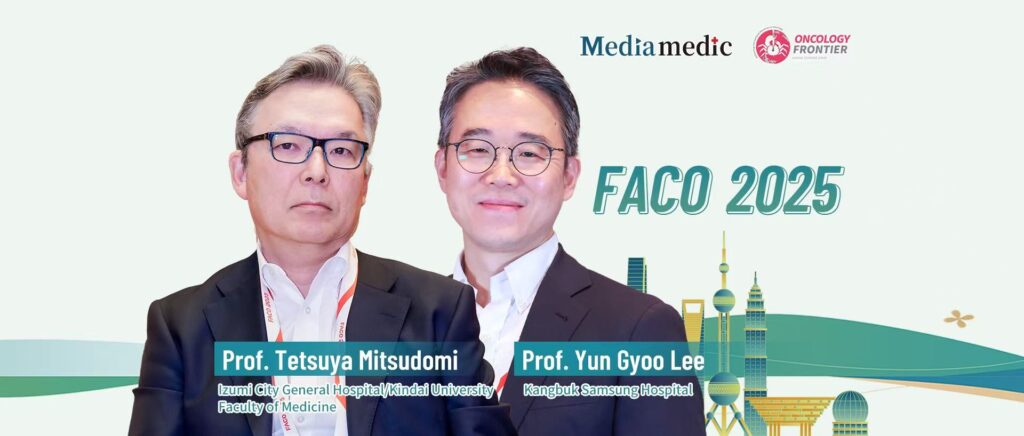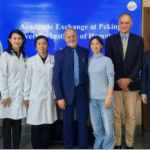
Editor’s Note: China, Japan, and South Korea have long ranked among the countries with the highest incidence of lung cancer worldwide. With a heavy disease burden, urgent unmet medical needs, and remarkably similar disease characteristics, strengthening trilateral collaboration among these East Asian nations is critical to advancing clinical oncology and addressing shared challenges in lung cancer management.The 13th Federation of Asian Clinical Oncology (FACO) Annual Meeting, held in Shanghai from October 24–25, 2025, aimed to promote clinical oncology cooperation and innovation across Asia, particularly among China, Japan, and Korea. During the meeting, Oncology Frontier interviewed Professor Tetsuya Mitsudomi of Kinki University, Japan, former President of the International Association for the Study of Lung Cancer (IASLC), and Professor Yun Gyoo Lee of Seoul Kangbuk Samsung Hospital, Korea. The two experts shared their perspectives on recent advances in lung cancer therapy and discussed the future of trilateral academic cooperation in East Asia.
Part 1 – Continued Optimization of Perioperative Therapy for Early-Stage Lung Cancer: Targeted and Immunotherapies Lead the Way
Oncology Frontier: Your FACO presentation focused on “New Therapeutic Pathways and Clinical Outcomes in Early-Stage Non–Small Cell Lung Cancer (NSCLC)”. Regarding perioperative immunotherapy for driver-negative NSCLC, what treatment models are most commonly adopted in Japan, and what is your personal preference? What factors most influence treatment selection?
Prof. Tetsuya Mitsudomi: The first perioperative regimen approved for NSCLC in Japan was based on the IMpower010 study—adjuvant atezolizumab. This was followed by CheckMate-816, which introduced neoadjuvant nivolumab plus chemotherapy, and then the KEYNOTE-671 perioperative regimen—neoadjuvant plus adjuvant pembrolizumab. Most recently, another perioperative immunotherapy approach from the AEGEAN study was also approved.
In Japanese clinical practice, treatment adoption followed this sequence. Initially, the IMpower010 adjuvant regimen was used, but as immunotherapy works best when the tumor and immune system remain intact, neoadjuvant therapy is theoretically more effective. Indeed, trial data show stronger hazard ratios favoring neoadjuvant use, prompting a gradual shift among Japanese clinicians from adjuvant-only to perioperative or neoadjuvant-first strategies.
The current debate centers on whether postoperative adjuvant immunotherapy is always necessary after neoadjuvant therapy—essentially, whether to adopt KEYNOTE-671/AEGEAN or CheckMate-816. I personally favor neoadjuvant or perioperative immunotherapy, though the value of adjuvant treatment remains under evaluation. For patients unable to tolerate cisplatin (as required in KEYNOTE-671), the CheckMate-816 regimen remains a viable alternative.
Oncology Frontier: As a participant in several perioperative targeted therapy trials for EGFR and ALK-mutated early NSCLC, how would you assess the efficacy of current regimens? For rarer alterations such as ALK, how can trial design be optimized to accelerate results that can directly inform clinical practice?
Prof. Tetsuya Mitsudomi: For patients harboring EGFR or ALK driver mutations, postoperative TKI therapy—based on ADAURA (osimertinib) and ALINA (alectinib)—is the current standard of care. We routinely prescribe these agents when the corresponding mutations are detected.
However, for rarer genetic alterations, such as RET fusions, it is extremely challenging and costly to conduct phase III trials large enough to demonstrate benefit. The ongoing selpercatinib adjuvant trial is one such effort, but it will require broad multinational participation to succeed.
Moreover, not all drugs effective in stage IV disease necessarily provide benefit in the adjuvant setting. Some patients may already be cured by surgery alone, which dilutes the measurable effect of TKIs. Therefore, in the future, clinicians may find themselves using TKIs in adjuvant settings without phase III data, particularly for ultra-rare mutations—a dilemma that no one yet has a perfect answer for.
Part 2 – Addressing EGFR-TKI Resistance: China’s Innovative TROP2 ADC Garners Global Recognition
Oncology Frontier: Your FACO presentation titled “Treatment Landscape After EGFR-TKI Failure in EGFR-Mutated NSCLC” addressed post-resistance management. In your practice, which regimens do you prioritize after failure of third-generation TKIs, and do you routinely perform re-biopsies to guide treatment decisions?
Prof. Yun Gyoo Lee: Today, nearly all EGFR-mutated advanced NSCLC patients receive third-generation TKIs as first-line therapy. However, resistance mechanisms post-progression are complex and heterogeneous, making treatment decisions challenging.
In principle, re-biopsy is crucial to identify the mechanism of resistance and guide subsequent therapy. For example, in patients with MET amplification, we typically use MET-TKIs or MET/EGFR bispecific antibodies after third-generation TKI failure. I am personally involved in a clinical study in this area, so I strongly advocate for re-biopsy.
Meanwhile, antibody–drug conjugates (ADCs) are emerging as promising post-TKI options. Our team is leading and participating in several ADC-related trials to define the best therapeutic strategies. While chemotherapy remains the current standard after TKI failure, I believe that in the near future, “an ADC will outperform chemotherapy.”
Oncology Frontier: At the recent ESMO Congress, the Chinese-developed TROP2 ADC—luvasatrotuzumab—demonstrated positive results in the OPTiTROP-Lung04 trial for patients with EGFR-TKI–resistant NSCLC, published simultaneously in The New England Journal of Medicine. How do you view these findings, and which patient subgroups might benefit most?
Prof. Yun Gyoo Lee: I was genuinely impressed by the global impact of this China-only study. The TROP2 ADC luvasatrotuzumab doubled median PFS—from 4.3 months to 8.3 months—and became the first TROP2 ADC to show a superior benefit over standard chemotherapy.
While additional data from other TROP2 ADCs are awaited, this result is highly encouraging. It suggests a new treatment paradigm for patients with EGFR-TKI resistance, though further preclinical and translational work is needed to identify biomarkers that predict optimal benefit from TROP2 ADC therapy.
Part 3 – Leveraging FACO as a Platform for China–Japan–Korea Collaboration in Lung Cancer
Oncology Frontier: China has achieved remarkable progress in innovative lung cancer therapies, yet differences remain among China, Japan, and Korea in treatment standardization, precision medicine, and drug accessibility. Based on your experience collaborating with Chinese experts, which research areas should the three countries prioritize together?
Prof. Tetsuya Mitsudomi: I have visited China many times, and I’m consistently impressed by the energy and innovation of Chinese oncologists. They are actively developing new therapeutic strategies, particularly in immunotherapy and targeted therapy.
China is producing several globally competitive drugs, such as the PD-1/VEGF bispecific antibody ivonescimab, whose impressive activity has attracted worldwide attention. As a surgeon, I look forward to collaborating on its application in perioperative settings.
That said, there are substantial systemic differences between Japan and China. Over half of Japanese NSCLC patients are diagnosed at stage I, and Japan’s early-detection system has led to some of the best survival outcomes globally. In contrast, the disease-stage distribution and access to therapies in China are more heterogeneous, presenting unique challenges. I would be eager to collaborate in helping build effective lung cancer screening systems and optimize clinical practice in China.
Prof. Yun Gyoo Lee: China’s achievements in oncology innovation are impressive and widely recognized in Korea and beyond. However, many Chinese clinical trials enroll only Chinese patients. To confirm the global applicability of new therapies, it’s important to expand participation to include patients from Korea, Japan, and Western populations.
Korea, too, is investing heavily in independent drug development. I hope that in the near future, China and Korea will co-develop new therapies and jointly conduct clinical trials. The FACO meeting represents the first and most critical step in this collaborative journey—laying the foundation for sustained scientific cooperation among East Asian oncology communities.
Prof. Tetsuya Mitsudomi Professor of Thoracic Surgery, Kinki University School of Medicine Former President, International Association for the Study of Lung Cancer (IASLC)
Prof. Yun Gyoo Lee Professor of Oncology, Seoul Kangbuk Samsung Hospital

